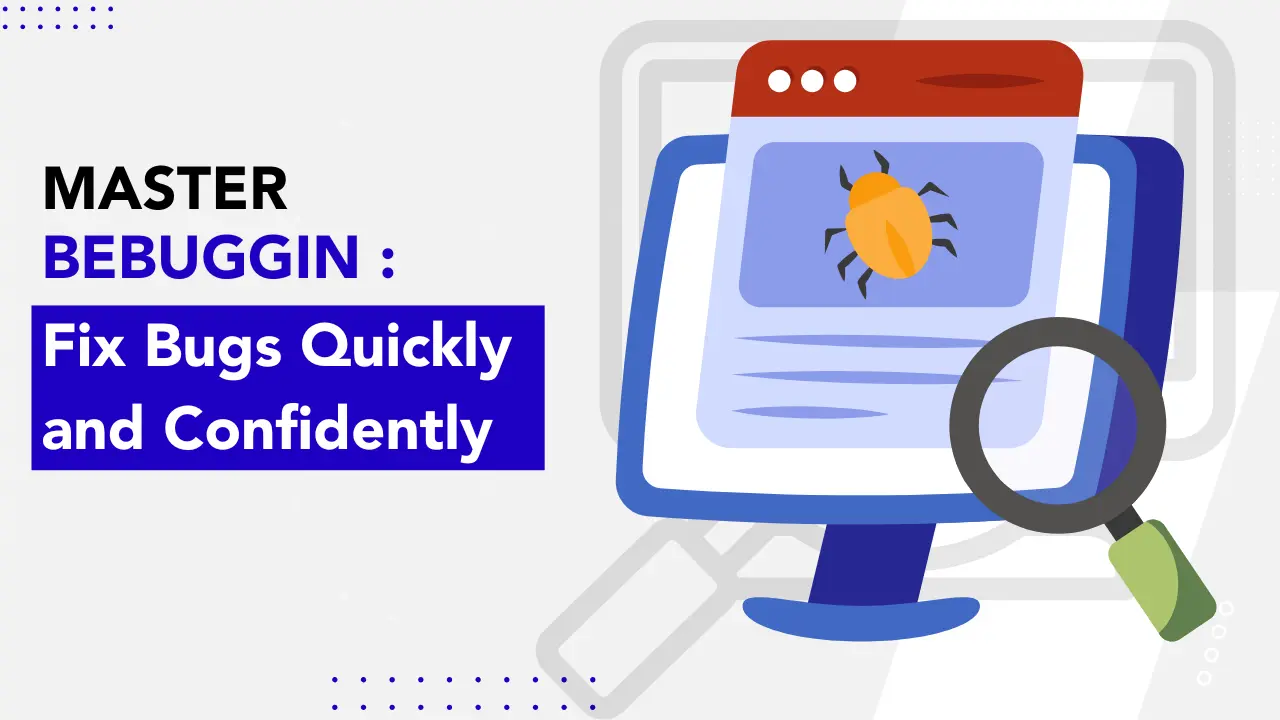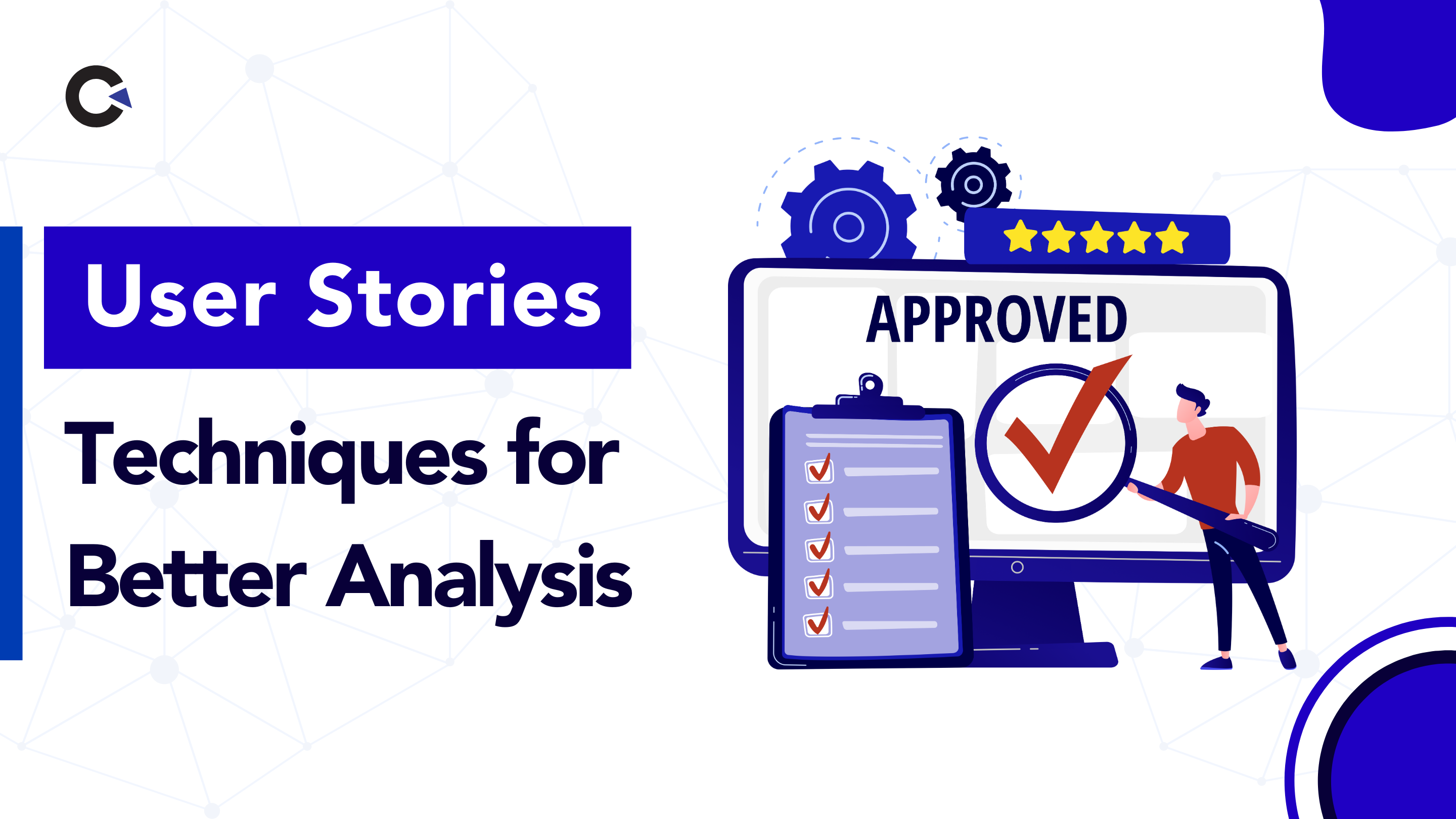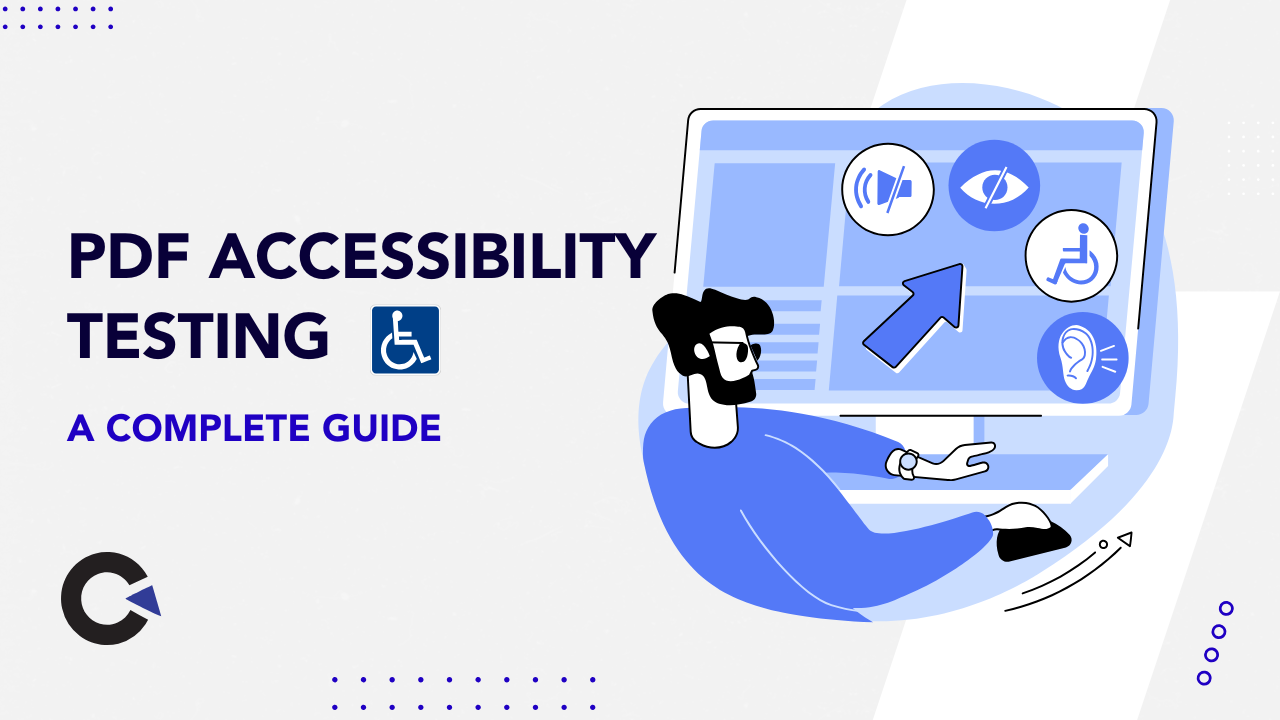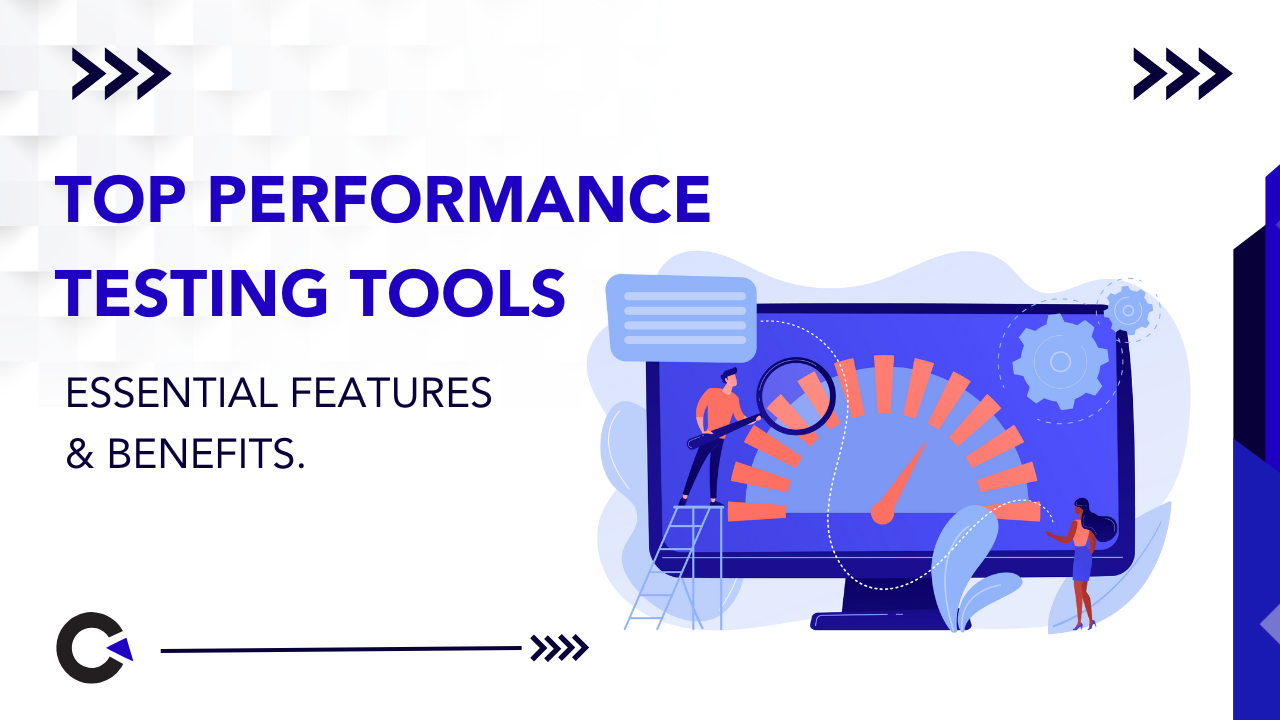
by admin | May 25, 2021 | Software Testing, Blog |
Test cases are documentations that consists of line-by-line instructions that define how testing has to be done. Test cases are very crucial when it comes to testing, as it acts as a well-defined guide for the testing team to validate if the application is free from bugs. Another important aspect is that test cases help to verify if the application meets the client’s requirements. So if a test case is written on the go without any planning or effort, it will result in huge losses, as a mistake here would act like a domino effect that impacts all the upcoming stages of testing. As one of the best software testing companies in the market, we have seen great results when effective test cases were implemented. So in this blog article, we will be focusing on how you can effectively write test cases.
What are the Headers that should be present in a Test Case?
Before we discuss on How to Write Effective Test Cases, let’s cover the basic aspects that every test case must have.
Name of the Project:
Whenever we write any test case, we should make sure to mention the name of the project to avoid any unnecessary confusion.
Module Name:
The software will usually be broken down into different modules so that they can be tested separately. So it is important to give each module a unique name so that different methods of testing can be assigned and implemented without any errors.
Reference Document:
A software requirements specification (SRS) or the Customer Requirement Specification (CRS) must be specified so that the testing team can test the application based on it.
Created By:
Every written piece of content would have an author and so make sure to mention the name of the person or the team that has created the test cases. Though it is not mandatory to include the designation of the person, it is recommended that you do so.
Test Case Created Date:
It goes without saying that when all the above information is vital, the date would be important as well. So make sure to specify the date that the test team should start testing, as it helps set a deadline.
Test Case ID:
Each and every Test Case should have a unique individual ID. It is like how each student has their own and unique identification number. It will help locate the test case if you want to reuse it or be helpful for any future references.
Test Scenario:
It acts as a descriptive guide that helps us understand each step. It also highlights the objective of the action that we are going to perform in the Test case.
Test Script (or) Steps:
Every step that should be carried out has to be mentioned under the Test Steps header. It is like explaining each step in an in-depth manner so that the testing test doesn’t miss out on any step resulting in deviations from the client requirement.
Test Data:
Mentioning what input should be given in each step is equally important while testing the application. It helps to keep the testing process on track without any missteps.
Expected Result:
The primary objective of any test is to verify if the expected or desired result is achieved at the end. The client requirement can be firmly established by properly defining the expected result to make the application error-free. Let’s take a look at an example to get a better understanding.
Example: If the user turns ON the fan switch, the Fan should rotate in an anticlockwise direction.
The expected result here is that the fan should rotate in the anticlockwise direction when it is switched on.
Actual Result:
But we cannot expect the result to be as expected in every scenario. That is why we have to make a note of the actual results we obtain while executing the test.
Example: In the same scenario as discussed above, it doesn’t mean that everything is working fine if the fan rotates. It must be verified according to the expectation and see if the fan rotates in the anticlockwise direction. If the fan rotates in the clockwise direction, we should make sure to make a record of it.
Status (or) Comment:
Once we have the expected result and the actual result, we will be able to come to a conclusion and decide if the application passed the test or not. Apart from updating the status, we can also add remarks about the result such as special scenarios and so on. We can also compare this to a student’s report sheet which denotes if the student has passed or failed and would have remarks based on the result as well.
What is the Difference Between Test Case and Test Scenario?
This could be a common question that arises in many minds when this topic is discussed. So we have created a tabular column to establish the key differences between a test case and a test scenario.
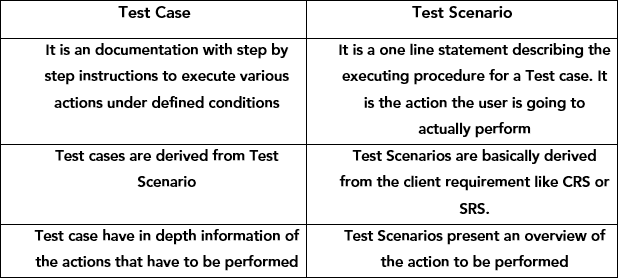
Sample Test Case:-
Now that we have gotten the basics out of the way, let’s dive into a full-fledged example and understand how to write effective test cases.
Test Scenario: A user has to send an email to someone else using their Gmail mobile application.
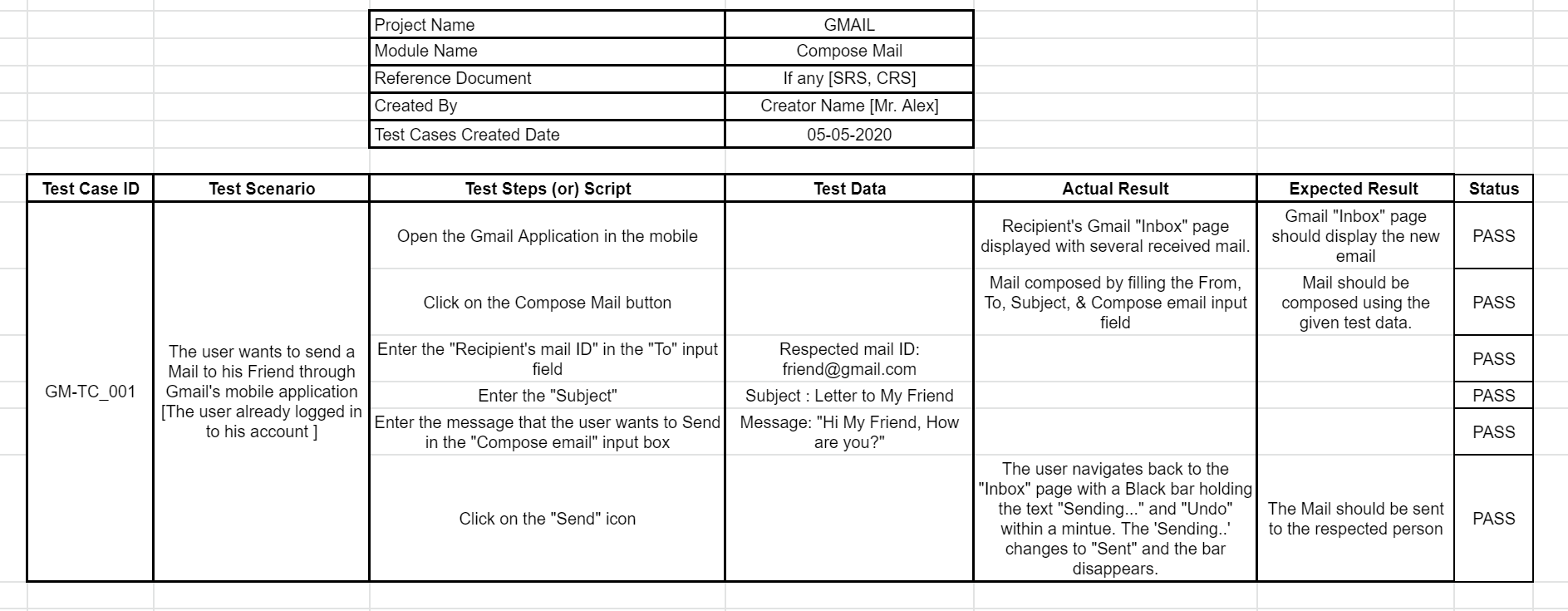
What are all the different types of Test Cases available?
Generally, test cases are classified into two main types,
i. Positive Test cases
ii. Negative Test cases
Positive Test cases:-
The Positive test cases do not differ much from the usual test cases, and so they are also known as formal test cases. A positive test case is used to very if the correct output is obtained when given the correct input.
Example:
Let’s say a user wants to transfer money through any UPI app, then he/she should find the correct recipient using their UPI ID or mobile number, enter the respected amount that they wish to transfer, and also enter the right UPI pin to complete the transaction. A positive test case would have the tester do the same actions by giving the correct input and seeing if everything works smoothly without any mishaps.
Negative Test cases:-
Negative Test cases are opposite to Positive test cases, as testers will provide an intentional negative or false input to make sure that the output is also negative. If we consider the same example we saw for positive test cases, the tester would try entering an incorrect UPI pin and see if the transaction fails. This is to make sure that only the authorized user will be able to operate the application, thereby increasing the security of the app. These tests are also called informal tests as they are not needed in every scenario, but they are pivotal in making sure that the application is secure.
Types of Positive Test Cases:-
Apart from the rare scenarios where negative test cases are used, positive test cases would be the more widely used preference. The Positive test cases can be further classified further based on the type of the project and the testing methods. But we will not be focusing on every type of test case as the other types are just subcategories of these 5 main types.
1. Functional Test cases
2. Integration Test cases
3. System Test Cases
4. Smoke Test cases
5. Regression Test Cases
Functional Test Cases:-
These test cases are written to check whether a particular functionality of the application is working properly or not.
Example:
If we take the same email sending example, then the test case that verifies if the send functionality is working correctly would be an apt example.
Integration Test Cases:-
These test cases are written to ensure that there is accurate data flow and database change across two combined modules or features.
Example:
The UPI money transaction example would fit well here too. During the transaction, the user enters the amount and enters the pin to complete the transaction. Once the transaction has been completed, the user will get a message about the deduction from their bank account as a result of the database change that has happened.
In this example, there is both data flow and database change between the two different modules.
System Test Cases:-
Earlier types saw us writing test cases only for a particular functionality or to see if the two modules work properly. But whenever the Testing environment is similar to the production environment, then the system test cases can be written to verify if the application is working correctly from its launch till the time it is closed. That is why this type of testing is also called end-to-end testing.
Example:
Here also we can take the same money transaction test case, but we have to test it starting right from the launch of the application to the successful transaction, and even until we receive the amount deduction message and have the transaction history updated in the user’s bank account.
Smoke Test Cases:-
Smoke tests that are also known as initial testing are very important in software testing as it acts like a preliminary test that every application should pass before extensive testing begins Smoke test cases should be written in a way that they check the critical functionalities of the software. We can then verify if the software is stable enough for further testing.
Example:
If we go back to the UPI payment app, then the testing team would have to test the application launch, account creation, and bank account addition before heading on to the transaction feature itself.
Regression Test Cases:-
Whenever the application gets any updates like UI updates, or new feature updates, the regression test cases come into play as they will be written based on the changes.
Example:
Let’s take an application most of us use on a daily basis, WhatsApp. Previously their testing team could have written test cases where the expected result could have been a list of emojis and the gif option being displayed when a user clicks on the Emoji option in the input text box.
But in one update, WhatsApp had introduced the stickers option. Since the new stickers would appear alongside the emojis and the gif option, the new test case would have been updated accordingly.
Guidelines on how to write effective test cases:
We have covered all the basic requisites that a test case must have and also the different types of test cases. This doesn’t necessarily mean that we can start writing perfect test cases right off the bat. So we will be covering a few important guidelines you should keep in your mind to write effective test cases.
1. CRS & SRS
The Testing team should be able to read and understand the Client requirements. But how is that made possible?
The client requirements for a project can be called a CRS or a Contract in simple terms. In this CRS document, the client will mention all their expectations about the software, such as how the software should perform and so on. This CRS document will be handled by the Business Analyst-(BA) of the company, and they will convert the CRS document into an SRS [System Requirement Specification] document.
The created SRS document has the functionality for each and every module and co-modules. Once the Business Analyst converts the CRS document into an SRS document they will provide the copy of the SRS document to the Testing and Development Teams. So the Testing team can read and understand the client requirement from the SRS.
2. Smoke Tests
Whenever we start writing the test cases, we should ensure to add smoke test cases to verify if the main functionality of the application is working.
3. Easy to Read
Writing easy-to-read test cases have advantages of their own. We can call it a success if a person who doesn’t have any technical knowledge can read the test cases and understand them clearly to work with the test cases.
4. Risk Evaluation
Writing extensive test cases that are not necessary should be avoided as it is a waste of resources. So proper risk evaluation has to be done prior to writing test cases so that the testing team can focus on the main requirement and core functionalities.
5. Format
The test cases always should start with either the application or the URL being launched, and it should end with the logging out option or closure of the application.
6. Avoid Assumptions
The Expected Result should be clearly captured for each and every test step, and all the features of the software (or) application should be tested without making any assumptions.
7. Dynamic values
Each and every step should not consist of multiple actions based on a single dynamic value. The dynamically changing values should not be hardcoded while writing the Test Cases. We have listed a few examples of such dynamic values.
Example:
Date, Time, Account Balance, Dynamically changing Game Slates, Reference Numbers, Points (or) Scores, etc.,
8. Dynamic Test Cases
But what should be done if we have to write a test case for a dynamically changing value? We can make use of common terms.
Example:
Let’s assume there is an online shopping site that is running a promotional campaign called ‘Happy New Year’ that provides its customers with a 20% off on their purchase. The dynamic value here is the campaign as it keeps changing in both name and value. So instead of writing a test case with the name of the one particular offer, it is better to use generic terms like ‘Promotional Campaign’
9. No Abbreviations
The Test cases should not be consist of any abbreviation (or) short forms. If in case the usage of an abbreviation is unavoidable, make sure to explain or define what it is in the test case. If not such open-ended information can lead to unnecessary mix-ups.
10. Optimal Distribution of Tests
A component level of verification should always happen only when you are writing functional test cases. You have to make sure that the same is not carried over when writing Integration and System Testing Test Cases. The Test Case document should cover all the types of the Test cases like Functional, Integration, System, and also Smoke Testing Test Cases.
How the test case helps the Testing team:
- Test case helps reduce the time and other resources required for testing.
- It helps to avoid test repetitions for the same feature of the application.
- It plays a major role in reducing the support maintenance cost of the software
- Even if we have to add a new member to the team during the course of the project, the new member will still be able to keep up with the team by reading the test cases.
- It helps to obtain maximum coverage of the application and fulfill the customer requirements
- The test cases help to ensure the quality of the software
- Test cases help us to think thoroughly and approach the process from as many angles as possible.
How to write effective test cases using the software?
The testing community has been writing test cases manually from the very beginning. But if you are looking for any software that reduces the time spent on writing test cases. You could take a look at the below test management systems,
Conclusion:
We hope you have enjoyed reading this blog. As a leading software testing service provider, we have always reaped the benefits of writing effective cases. But there is just no defined way to write test cases, as they are written in different formats depending on the project, the requirements, and the team involved. But we must always keep one point in our minds when we are thinking of how to write effective test cases, and that is to think from the point of view of the Client, Developer, End-User, and Tester. Then only we will be able to write quality test cases that will help us achieve 100% coverage.

by admin | May 18, 2021 | Software Testing, Blog |
Many companies run with Development and Operations teams working separately, which can cause problems in the long run. That is what DevOps plan can address: a collaborative approach that brings these two teams together. It streamlines and automates the software delivery lifecycle and aims to build better and more responsive software.
Contrary to popular belief, DevOps involves more than just a change in processes or tools. It is a cultural shift that removes barriers between teams to respond more efficiently to changing business requirements. As a result, it helps optimize workflow, deliver high-quality applications, and achieve other business goals.
Most organizations prefer continuous testing, but some are struggling to have a solid foundation for test automation. To address this, here are the methods to develop a DevOps testing strategy:
1. Scale test automation
Building a successful DevOps testing strategy requires scale test automation on the web and mobile. To scale web testing, use DIY, containerized computing, and cloud. For scaling mobile testing, opt for DIY, crowdsourcing, and cloud testing labs. Other options for scaling web and mobile testing are doing codeless and using open source frameworks.
2. Use supporting frameworks
Another method to create a DevOps testing strategy is to use supporting frameworks. To do this, provide assertion functions, a testing structure, mocks, spies, stubs, and a browser or browser-like environment with control of UI testing, scenario execution, and more.
Don’t forget to generate code coverage reports and display and watch test results. You also need to rely on a secure and up-to-date robust lab that can scale, is always available for all testing types, and can support all advanced automation capabilities.
3. Maintain a stable test automation suite
Since your product code is ever-changing, testing must also keep up with these changes. A stable test automation suite is crucial to ensure that automation continuously adds value. It has to be constantly maintained, audited, and refactored whenever required.
4. Use headless browsers
Headless browsers are developer-friendly tools that affect your testing strategy for web apps. Using them delivers a more stable build. Best of all, they are free, which can help you save money in the long run.
To use headless browsers, setting up Selenium Grid is not required. You just plug Google Puppeteer into your environment to do accessibility testing, performance auditing, and unit testing in JavaScript. This tactic helps scale test automation.
5. Use advanced reporting and analysis
Every testing activity requires a test report. Ensure to use a robust reporting platform and create detailed and actionable reports to help developers determine the root cause of issues and address them quickly.
6. Involve the full team in testing
When doing test automation at scale, involve the entire team. Assign business testers for exploratory and structured manual testing. On the other hand, software developers will create code-based test automation scripts and unit and build acceptance tests.
Conclusion
The secret to frequent, high-quality software delivery and becoming more competitive in the industry is DevOps testing. Since testing’s success highly relies on how you incorporate DevOps culture into your company, consider following the suggestions listed above. Also, seek automation testing services like ours as they play a major role in DevOps testing strategy.
If you need assistance from the best QA company, turn to us for help. At Codoid, we take pride in being an industry leader in QA. We offer analytics testing services, performance testing services, mobile application testing services, and more. Contact us to learn more about how we can help you!

by admin | Apr 27, 2021 | Software Testing, Blog |
Are you someone who wants to run their test cases on multiple browsers or machines? Then this BrowserStack Tutorial is a must-read for you as without it, you could be spending a lot of time, money, and effort to set up the multiple browsers or machines needed to perform the offline tests using real devices. As a premier Automation Testing Company in the market, we have opted for a cloud testing platform like BrowserStack that provides real cloud devices that consist of different platforms, browsers, and devices. BrowserStack is a cloud-based web and mobile testing platform using which is predominantly used by testers to perform Cross-browser testing of various web and native mobile applications across different platforms, different browsers, and different devices.
So it has been established that using the cloud is the optimal choice. But why BrowserStack in particular when there are other cloud testing platforms are available could be a question looming in your mind. You will find the answer to that question in detail in this BrowserStack Tutorial. We have mentioned all the wonders you could do using BrowserStack and explained how to do it as well.
Why BrowserStack?
BrowserStack can be used to avoid the complexity of switching between the operating systems, browsers, and its different versions. When it comes to mobile application testing, we can avoid the hassle of having to buy all the mobile devices that are available today to perform the testing. BrowserStack is very flexible and scalable, making it possible to test anywhere and anytime. We can use BrowserStack as a remote lab, and we can even use it as Real Desktop Browsers or Mobile Browsers. There is no setup required for using Browser Stack. We can use it directly on any independent machine by using the Browser Stack URL and its login credentials. Yes, it is that simple.
There are 4 main features of BrowserStack that we will be exploring in this blog and they are namely, Live, Automate, App Live, and App Automate. Let’s get the ball rolling by exploring the ‘Live’ feature.
BrowserStack Tutorial for Live/Manual Testing Feature
The Live option will help you perform manual testing in a list of real cloud device platforms like Android, iOS, Windows Phone, Windows, and Mac. Once you select any platform, it will show a list of browsers like Chrome, Mozilla, IE, UC Browser, and Safari with different versions. Once you have selected the browser of your choice, it will create a session and open a browser. You can simply enter the URL of the site and kick start your manual testing the same way you would do on a real device.
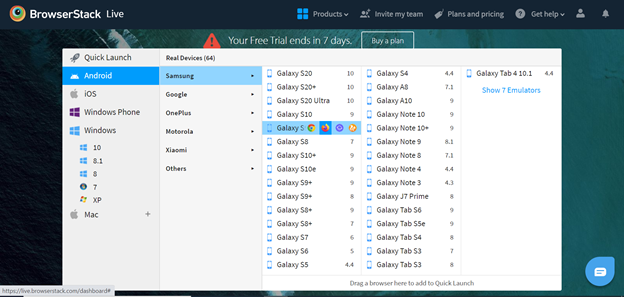
Key Features in Live:
1. Switch Browser:
If you want to check the compatibility of the testing site in another browser, it is not necessary to close the current browser to switch to the other one. You can simply choose the ‘Switch Browser’ option, and it will display the device platform and browser list from which you can select the device and browser.
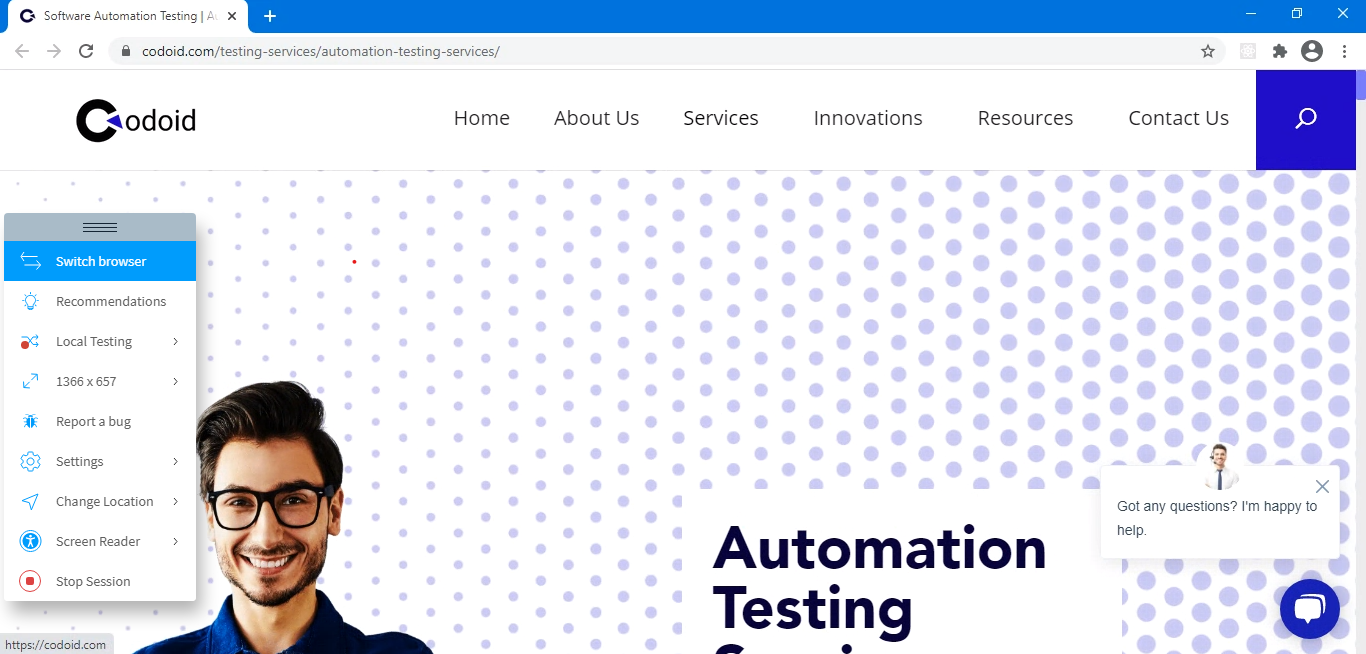
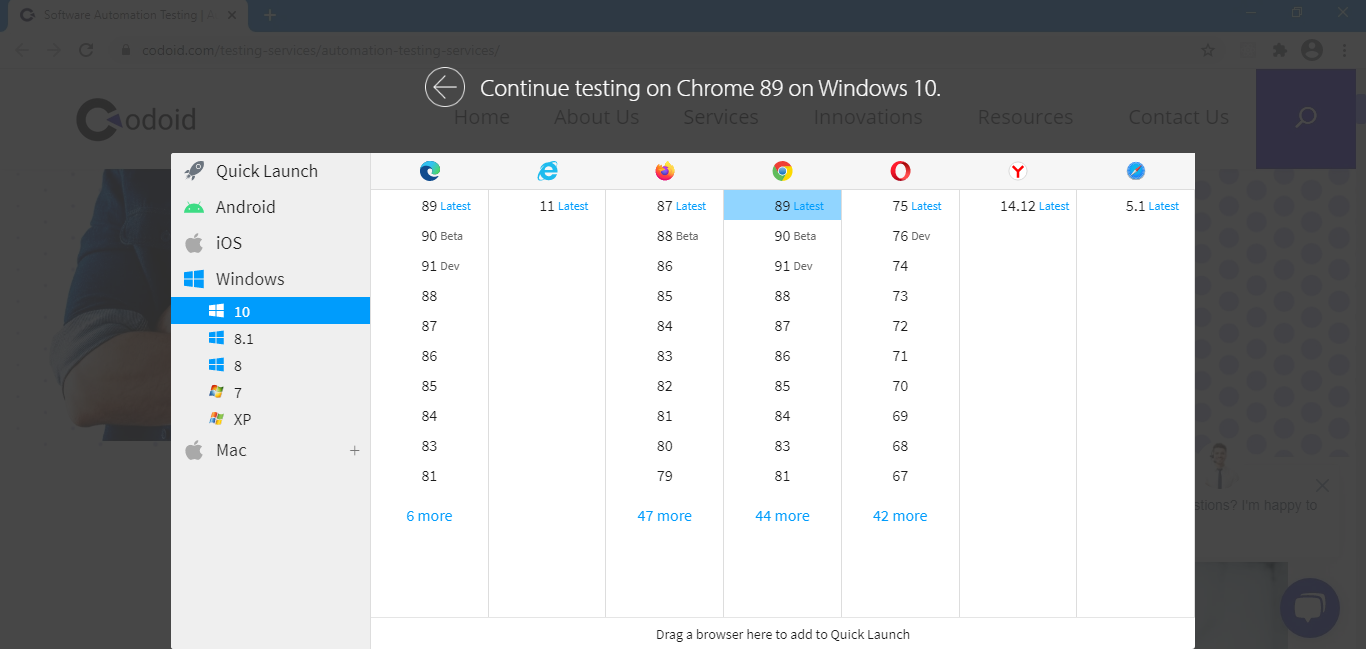
2. Resolution:
If you need to test your site in different screen resolutions, then you can make use of the ‘Resolution’ option. Once the ‘Resolution’ option is selected, a list of the available resolutions will appear, and you can select the required resolution to carry on with your testing as per your needs.
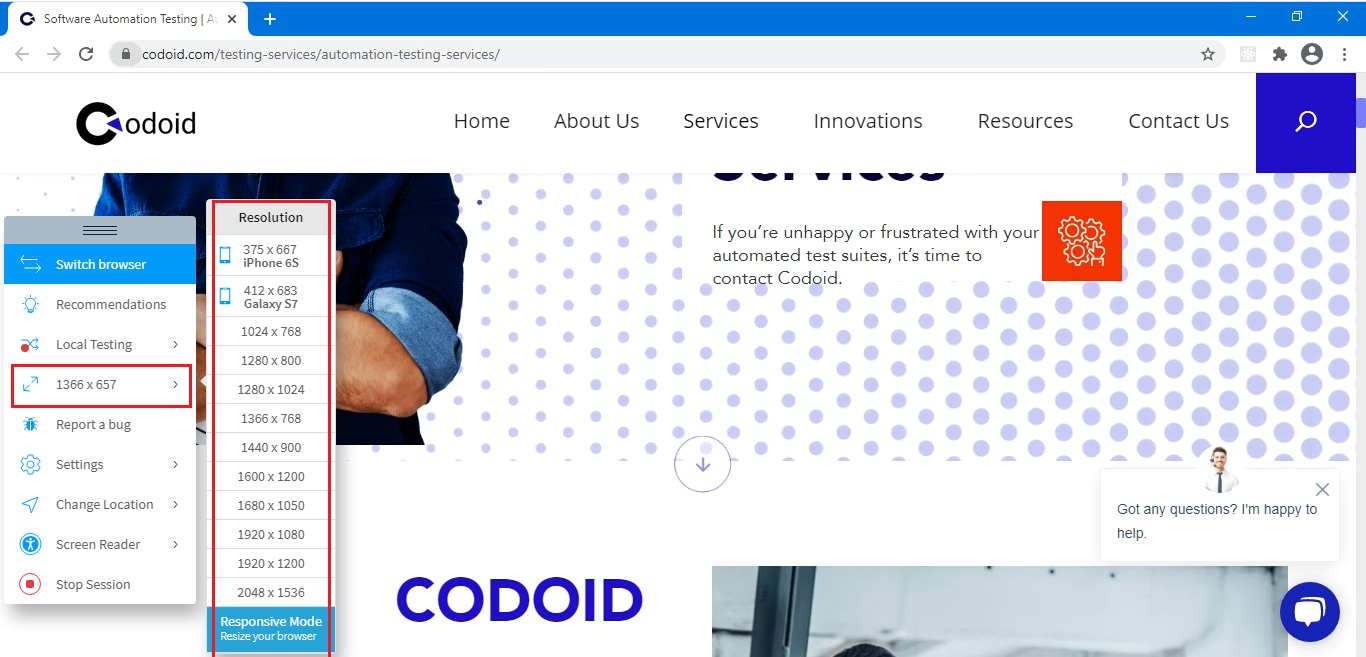
3. Reporting a Bug using BrowserStack:
The primary objective of testing across so many platforms and devices is to identify and report the bugs that are present so that the end-user doesn’t face any difficulty. Once you have found a bug, you can report it by clicking on the Report a Bug option. After you click on this option, you will see an option box to highlight the issue on the page. You can highlight the issue by using different options like rectangle, circle, pencil, etc.
In addition to that, you can even select the mode to report a bug. There are so many tools like Jira, Trello, GitHub, and Slack through which you could report the bugs. You can even share it by email or download the issue page if needed.
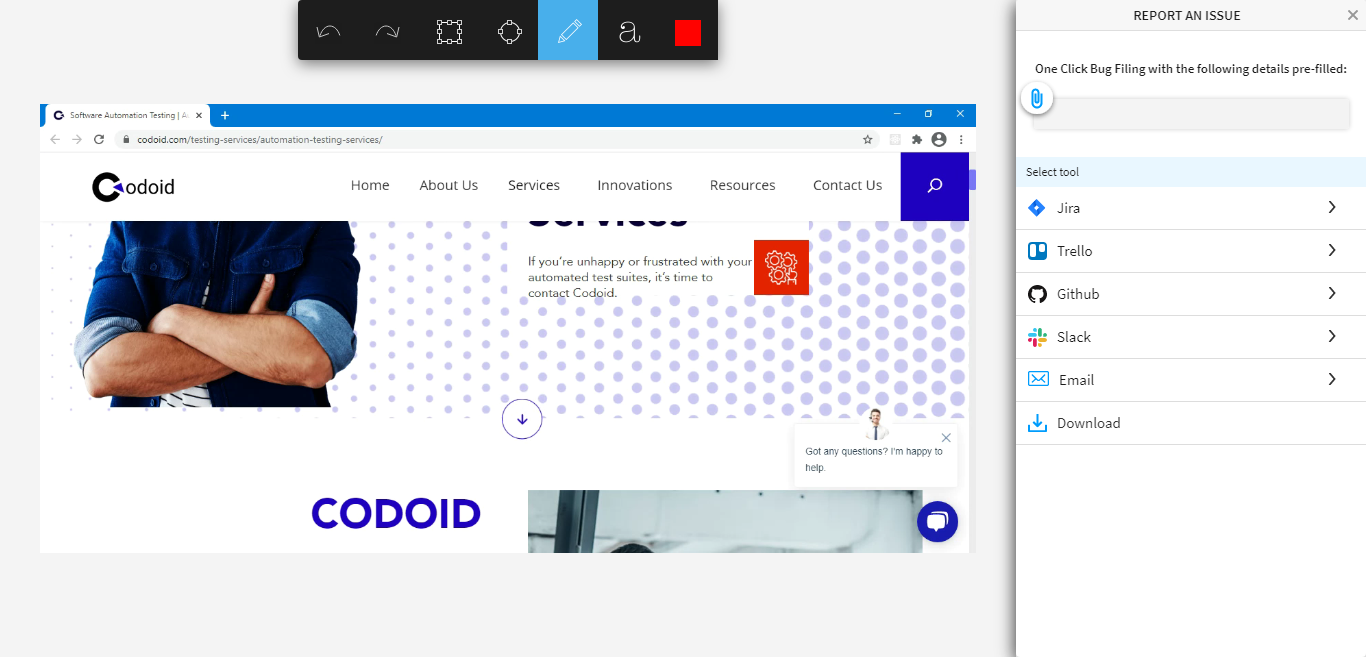
4. Local Testing:
BrowserStack enables users to run tests on their internal development environments, on their localhost, or even behind a corporate firewall. This feature is called ‘Local Testing’.
Local Testing establishes a secure connection between the user’s machine and the BrowserStack cloud. Once Local Testing is set up, all the URLs will work straight out of the box, including the HTTPS URLs and also the ones behind a proxy or firewall.
BrowserStack local testing can be enabled for both ‘Live’ and ‘Automate’.
5. Local Testing Live
Download the BrowserStack local application from the local testing option and install it on your machine. Start the application, and you’ll see the BrowserStack local icon in the system tray area.
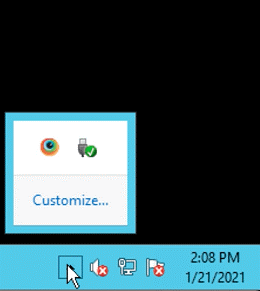
This enables Local Testing. Start a Live session and look for a green indicator on the Local Testing icon in the toolbar dock. You can launch the Live dashboard right from the app by just clicking on the BrowserStack Local app and navigating to Launch > Live.
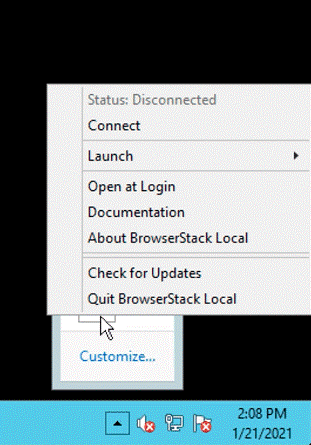
To resolve all requests to local URLs via your machine, click on the Local Testing icon and check the ‘Resolve all URLs through my network’ option.
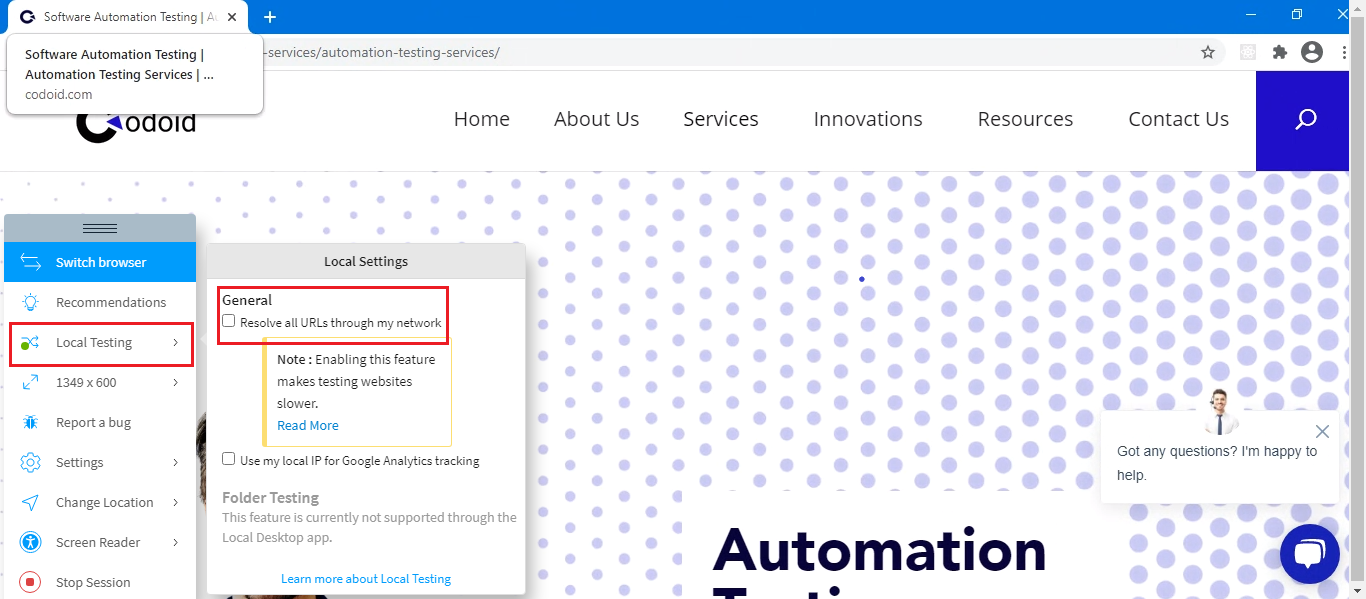
6. Local Testing Automate
We wanted to leave no stone unturned in this BrowserStack Tutorial and so we have listed the numerous Frameworks and languages that are supported in BrowserStack in the image below.
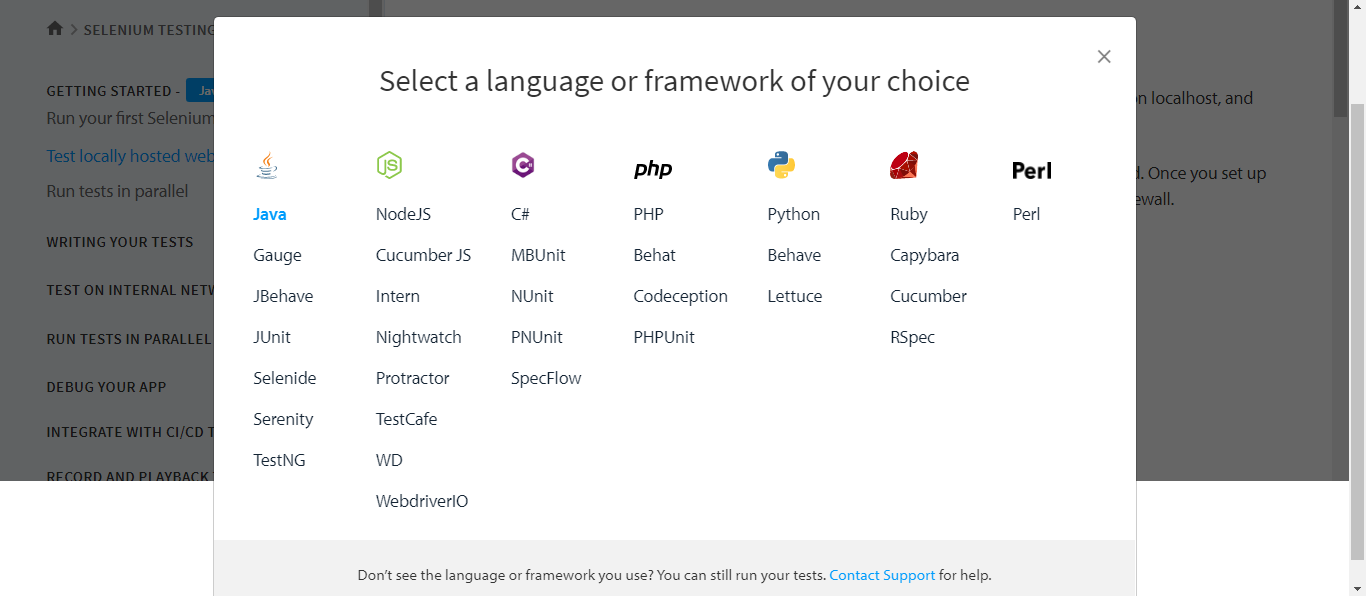
We can enable and disable local testing automatically using the code snippet in our test scripts. In this example, we have used Java language, and so it displays the Java BrowserStack local dependency. We need to add this dependency in pom.xml
<dependency>
<groupId>com.browserstack</groupId>
<artifactId>browserstack-local-java</artifactId>
<version>1.0.3</version>
</dependency>
This code snippet starts and stops BrowserStack local while running our test scripts.
import com.browserstack.local.Local;
# creates an instance of Local
Local bsLocal = new Local();
# replace <browserstack-accesskey> with your key. You can also set an environment variable - "BROWSERSTACK_ACCESS_KEY".
HashMap<String, String> bsLocalArgs = new HashMap<String, String>();
bsLocalArgs.put("key", "<browserstack-accesskey>");
# starts the Local instance with the required arguments
bsLocal.start(bsLocalArgs);
# check if BrowserStack local instance is running
System.out.println(bsLocal.isRunning());
#stop the Local instance
bsLocal.stop();
Steps involved in enabling BrowserStack local automate via command line:
1. Download the appropriate binary for your system:
- OS X (10.7 and above)
- Linux 32-bit
- Linux 64-bit
- Windows (XP and above)
2. Unzip the binary to a folder/directory on your machine.
3. Open your command-line interface and navigate to the folder containing the Local binary.
4. Run the binary using the following command:
BrowserStackLocal.exe --key sdfsdfsdfsgfggffsgdfg
After establishing the Local Testing connection, set the browserstack.local capability to true by adding the following snippet to your script:
caps.setCapability("browserstack.local", "true");
BrowserStack Tutorial for using the Automate Feature:
With the help of the ‘Automate’ feature we can use BrowserStack’s real cloud devices to automate our test scripts. The same languages and frameworks that were supported in Local Testing Automate will also be supported for Automate. So we can choose any language and framework from the list that we saw earlier. In this BrowserStack Tutorial, we will be using java to explain the BrowserStack Automate feature.
a) Selecting the OS and device/browser combination
You can easily select the OS and Device/Browser combination you’d like to test on, using the drop-down menus as shown below.
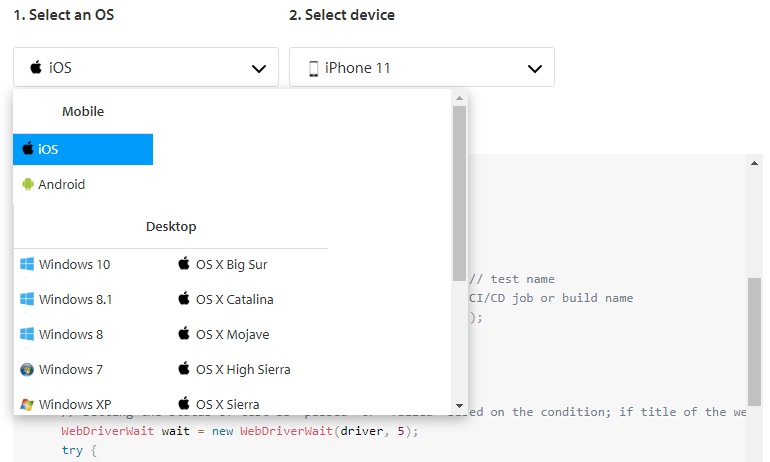

For the above-selected combination, the BrowserStack sample code will be automatically generated. Now we can set up the sample code in the framework to run our test scripts in BrowserStack. Write the variables for the user name and access key. Pass the user name and password in BrowserStack URL. Set the desired capabilities to see the logs. We are setting the desired capabilities to tell the web driver, to choose the mentioned operating system, browser, and browser version. Create the object for the web driver and get the URL to open the website.
import org.openqa.selenium.By;
import org.openqa.selenium.Platform;
import org.openqa.selenium.WebDriver;
import org.openqa.selenium.WebElement;
import org.openqa.selenium.remote.DesiredCapabilities;
import org.openqa.selenium.remote.RemoteWebDriver;
import org.openqa.selenium.JavascriptExecutor;
import java.net.URL;
import org.openqa.selenium.support.ui.ExpectedConditions;
import org.openqa.selenium.support.ui.WebDriverWait;
public class JavaSample {
public static final String AUTOMATE_USERNAME = "<USERNAME>";
public static final String AUTOMATE_ACCESS_KEY = "<ACCESSKEY>";
public static final String URL = "https://" + AUTOMATE_USERNAME + ":" + AUTOMATE_ACCESS_KEY + "@hub-cloud.browserstack.com/wd/hub";
public static void main(String[] args) throws Exception {
DesiredCapabilities caps = new DesiredCapabilities();
caps.setCapability("browserName", "iPhone");
caps.setCapability("device", "iPhone 11");
caps.setCapability("realMobile", "true");
caps.setCapability("os_version", "14.0");
caps.setCapability("name", "BStack-[Java] Sample Test"); // test name
caps.setCapability("build", "BStack Build Number 1"); // CI/CD job or build name
WebDriver driver = new RemoteWebDriver(new URL(URL), caps);
driver.get("https://www.google.com");
WebElement element = driver.findElement(By.name("q"));
element.sendKeys("BrowserStack");
element.submit();
// Setting the status of test as 'passed' or 'failed' based on the condition; if title of the web page contains 'BrowserStack'
WebDriverWait wait = new WebDriverWait(driver, 5);
try {
wait.until(ExpectedConditions.titleContains("BrowserStack"));
markTestStatus("passed","Yaay title contains 'BrowserStack'!",driver);
}
catch(Exception e) {
markTestStatus("failed","Naay title does not contain 'BrowserStack'!",driver);
}
System.out.println(driver.getTitle());
driver.quit();
}
// This method accepts the status, reason and WebDriver instance and marks the test on BrowserStack
public static void markTestStatus(String status, String reason, WebDriver driver) {
JavascriptExecutor jse = (JavascriptExecutor)driver;
jse.executeScript("browserstack_executor: {\"action\": \"setSessionStatus\", \"arguments\": {\"status\": \""+status+"\", \"reason\": \""+reason+"\"}}");
}
}
b) Execution process:
- Once the script starts its execution, it will trigger the BrowserStack to run the script.
- Every script execution will be maintained as a session with a unique session ID.
- Under ‘All projects’, the scripts that are running and the ones that have been executed will be displayed.
- Once the Script has started execution, all the logs will start getting recorded.
- We can see a live video about what’s happening during the execution in BrowserStack.
- Once the execution has been completed successfully, the Status will be changed from ‘Running’ to ‘Completed’. It will be denoted using a Green color dot.
- If the execution has failed because of any error, then the Status will be ‘Errors’.
- If the session had timed out, then the Status will be mentioned as “Timeout”, and the status will be denoted using a Yellow color dot.
Observe the automate tab. We can see the test name on the left side of the tab, where BrowserStack enables us to debug the code with the help of Text Logs, Visual Logs, and Video of the session
- Text Logs: They provide all the Information with the details of actions and timing.
- Visual Logs: They provide the details with screenshots.
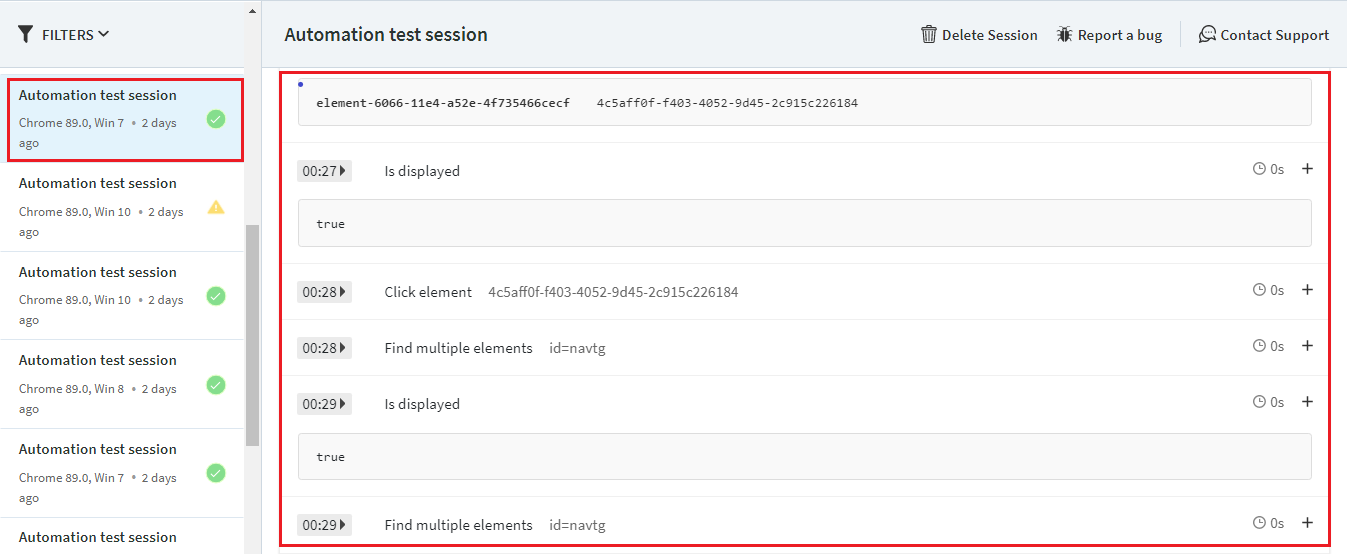
- Video: It records all the actions done through the automated script. It helps to identify the exact root cause of any error during execution.
It also has the option to play or download the video, using which we can watch the video in the dashboard or download it and use it to debug the error.
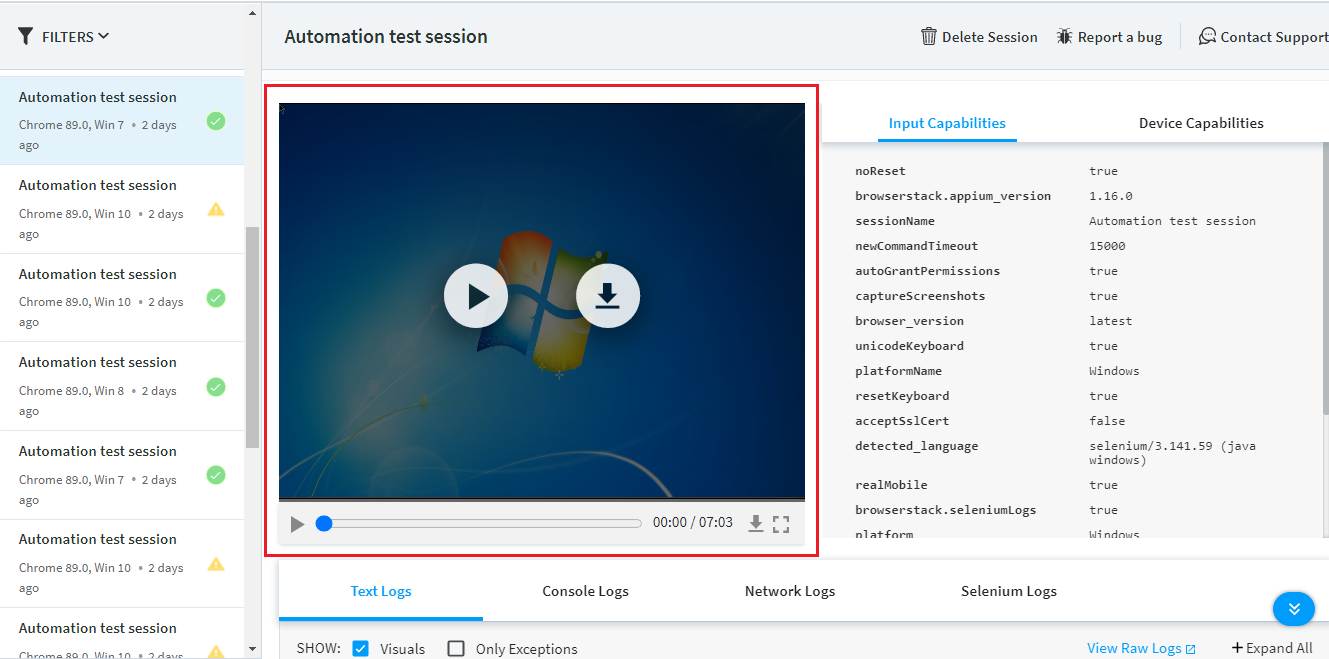
c) Run Tests in Parallel
On BrowserStack, we can run multiple Selenium WebDriver tests at the same time across various browser, device, and OS combinations. This is called Parallel Testing. Parallel Testing gives us the same benefits as running a multi-threaded application. We wanted to make sure that our BrowserStack Tutorial does more than just introduce you to the tool. We wanted everyone reading this blog to make use of BrowserStack’s full potential.
With Parallel Testing, we can run the same test on different browser/device combinations i.e. cross-browser testing, or run different tests on the same or different browser/device combinations as explained above. Parallel Testing will help us drastically reduce the run time of our test suite, resulting in faster build times and faster releases.
We can start testing in parallel using any of the popular test frameworks, and some of the popular frameworks are mentioned below:
- TestNG
- Gauge
- JBehave
- JUnit
- Selenide
- Serenity
Here, we are going to use the TestNG framework to explain Parallel Testing in detail.
To run the tests on multiple browsers in parallel with TestNG on BrowserStack Automate, follow the below steps:
1. Clone the testng-browserstack repo on GitHub (if not already done):
2. git clone https://github.com/browserstack/testng-browserstack.git
3. cd testng-browserstack
4. Install the dependencies using the following command:
5. mvn compile
6. Update parallel.conf.json files within the testng-browserstack/src/test/resources/conf directory with your BrowserStack credentials as shown below:
parallel.conf.json
{
"server": "hub-cloud.browserstack.com",
"user": "USERNAME",
"key": "ACCESSKEY",
"capabilities": {
"build": "testng-browserstack",
"name": "Bstack-[TestNG] Parallel Test",
"browserstack.debug": true
},
"environments": {
"chrome": {
"browser": "chrome"
},
"firefox": {
"browser": "firefox"
},
"safari": {
"os": "OS X",
"browser": "safari"
},
"ie": {
"browser": "internet explorer"
}
}
}
7. You can now run your tests in parallel on BrowserStack using the following command
d) How to Run tests in parallel without a framework
We have also demonstrated how to run tests in parallel without a framework using a sample script that shows a multi-threaded Java program in this BrowserStack Tutorial. Before we head on to the script, let’s take a look at its salient points.
- The same script is run across 3 different browser/device combinations viz. iPhone 12 Pro, Samsung Galaxy S20, and Safari on Big Sur.
- The capabilities are being populated in a HashTable, and that is being passed on to the test function.
- The test function has been written as a separate method, and it takes care of the starting of the test for each of the browsers after iterating on the HashTable that is passed on to it.
- Multi-threading has been implemented by defining multiple classes, all of which implement the Runnable Java class.
- The main class contains the main() method, and all the 3 threads are invoked from the main class
import java.net.MalformedURLException;
import java.net.URL;
import java.util.Hashtable;
import java.util.Iterator;
import java.util.Set;
import java.util.concurrent.TimeUnit;
import org.openqa.selenium.By;
import org.openqa.selenium.JavascriptExecutor;
import org.openqa.selenium.WebDriver;
import org.openqa.selenium.WebElement;
import org.openqa.selenium.remote.DesiredCapabilities;
import org.openqa.selenium.remote.RemoteWebDriver;
import org.openqa.selenium.support.ui.ExpectedConditions;
import org.openqa.selenium.support.ui.WebDriverWait;
class TestClass1 implements Runnable {
public void run() {
Hashtable<String, String> capsHashtable = new Hashtable<String, String>();
capsHashtable.put("device", "iPhone 12 Pro");
capsHashtable.put("real_mobile", "true");
capsHashtable.put("os_version", "14");
capsHashtable.put("build", "BStack-[Java] Sample Build");
capsHashtable.put("name", "Thread 1");
mainTestClass r1 = new mainTestClass();
r1.executeTest(capsHashtable);
}
}
class TestClass2 implements Runnable {
public void run() {
Hashtable<String, String> capsHashtable = new Hashtable<String, String>();
capsHashtable.put("device", "Samsung Galaxy S20");
capsHashtable.put("real_mobile", "true");
capsHashtable.put("os_version", "11.0");
capsHashtable.put("build", "BStack-[Java] Sample Build");
capsHashtable.put("name", "Thread 2");
mainTestClass r1 = new mainTestClass();
r1.executeTest(capsHashtable);
}
}
class TestClass3 implements Runnable {
public void run() {
Hashtable<String, String> capsHashtable = new Hashtable<String, String>();
capsHashtable.put("browser", "safari");
capsHashtable.put("browser_version", "14");
capsHashtable.put("os", "OS X");
capsHashtable.put("os_version", "Big Sur");
capsHashtable.put("build", "BStack-[Java] Sample Build");
capsHashtable.put("name", "Thread 3");
mainTestClass r1 = new mainTestClass();
r1.executeTest(capsHashtable);
}
}
public class mainTestClass {
public static final String USERNAME = "USERNAME";
public static final String AUTOMATE_KEY = "ACCESSKEY";
public static final String URL = "https://" + USERNAME + ":" + AUTOMATE_KEY + "@hub-cloud.browserstack.com/wd/hub";
public static void main(String[] args) throws Exception {
Thread object1 = new Thread(new TestClass1());
object1.start();
Thread object2 = new Thread(new TestClass2());
object2.start();
Thread object3 = new Thread(new TestClass3());
object3.start();
}
public void executeTest(Hashtable<String, String> capsHashtable) {
String key;
DesiredCapabilities caps = new DesiredCapabilities();
// Iterate over the hashtable and set the capabilities
Set<String> keys = capsHashtable.keySet();
Iterator<String> itr = keys.iterator();
while (itr.hasNext()) {
key = itr.next();
caps.setCapability(key, capsHashtable.get(key));
}
WebDriver driver;
try {
driver = new RemoteWebDriver(new URL(URL), caps);
JavascriptExecutor jse = (JavascriptExecutor)driver;
// Searching for 'BrowserStack' on google.com
driver.get("https://www.google.com");
WebElement element = driver.findElement(By.name("q"));
element.sendKeys("BrowserStack");
element.submit();
// Setting the status of test as 'passed' or 'failed' based on the condition; if title of the web page contains 'BrowserStack'
WebDriverWait wait = new WebDriverWait(driver, 5);
try {
wait.until(ExpectedConditions.titleContains("BrowserStack"));
jse.executeScript("browserstack_executor: {\"action\": \"setSessionStatus\", \"arguments\": {\"status\": \"passed\", \"reason\": \"Title matched!\"}}");
}
catch(Exception e) {
jse.executeScript("browserstack_executor: {\"action\": \"setSessionStatus\", \"arguments\": {\"status\":\"failed\", \"reason\": \"Title not matched\"}}");
}
System.out.println(driver.getTitle());
driver.quit();
} catch (MalformedURLException e) {
e.printStackTrace();
}
}
}
BrowserStack Tutorial for using the APP LIVE Feature
So the last feature that we will be seeing in this BrowserStack Tutorial is the App Live function that helps us to do native app testing in a list of real cloud devices. To use the native app in the BrowserStack devices, we can use the Upload or URL option.
a) Uploading/Testing the App
Click on the upload app button, and a system dialog window will open.
Go to the app folder, choose the App which you want to test, and the app will be loaded successfully. We will be able to see the app under the uploaded apps section.
This is not the only way to get this done, and you can upload the app in other ways as well. For example, you can click on ‘View all sources’ and select any type of source through which you are going to upload the app.
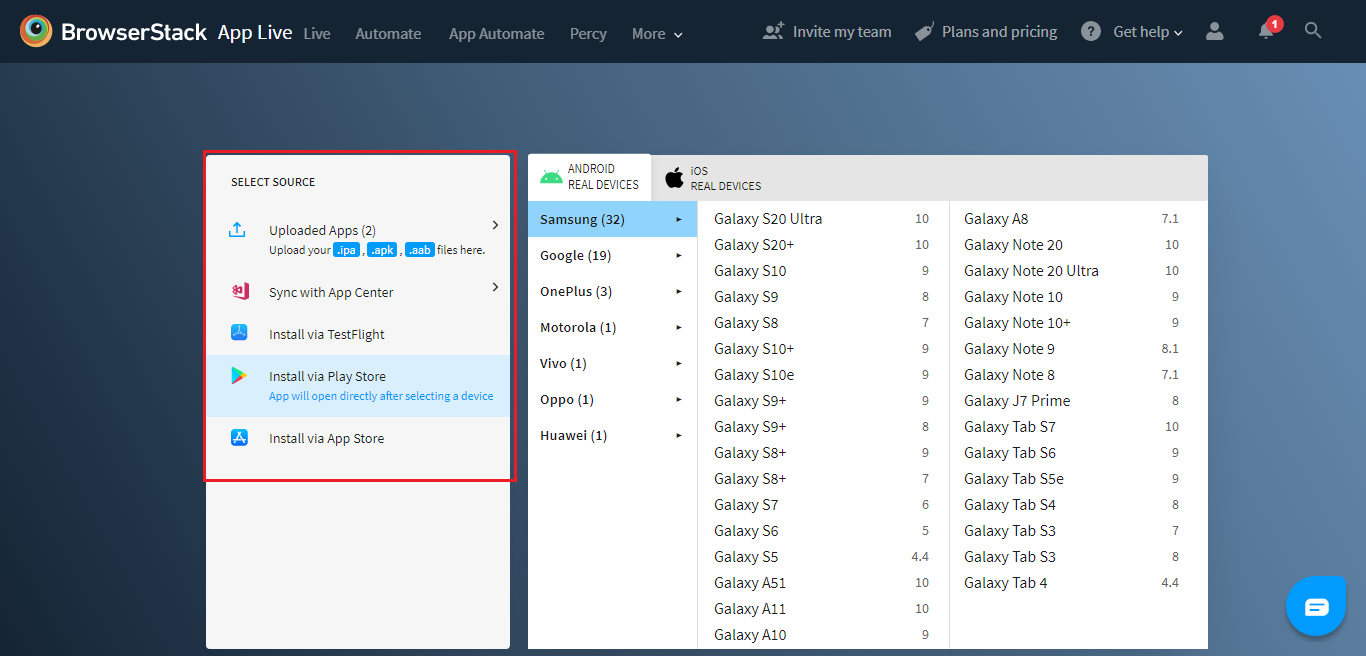
After Uploading the App, select any device from the list of real Android or iOS devices. The device of your choice will be selected, and the app will be installed in it. Now you are all set to perform testing like how you would do using a real device.
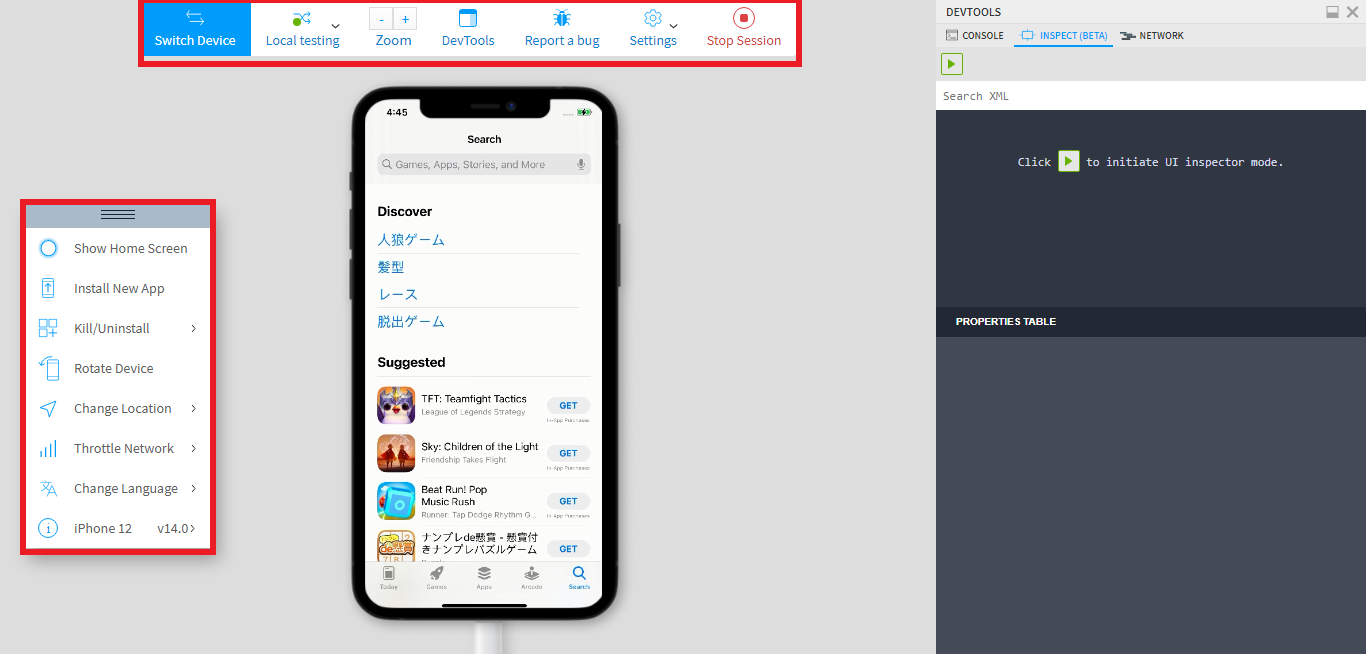
b) Key Functions of App Live
1) Switch Device Function
Just like how you can shift from one browser to another, you can migrate from one device to another to perform your testing as well. Click on the ‘Switch device’ option, if you wish to switch the device at any given time. Once you are done with testing in a particular device, click on the Stop session option and it will navigate you to the dashboard page. Click on settings to choose the session time out and monitor size.
We can report the bug by clicking on the Report a bug option, just like how we discussed in the above Live Testing Section. Now let’s take a look at the web tool kit menu, which has some more options to operate the device feasibly and test the application.
Click on the ‘Rotate Device’ option to rotate the device horizontally or vertically. You can click on the ‘Install App’ option to install the new application. If you want to just close the app and not the device, then click on the ‘Kill app’ option. Click on ‘Change language’ to change the language for testing. If you are looking to check the complete device information, click on the ‘Device info’ icon.
2) Deleting the App
Click on the delete icon, and you will see the checkbox at each app. Select the checkbox, and click on the delete link and it is also important to keep in mind that it will delete the uploaded app automatically after the completion of 60 days from the date of upload.
BrowserStack Tutorial for using APP AUTOMATE Feature
BrowserStack App Automate enables you to test native and hybrid mobile applications using a testing framework.

Here, we are going to use Appium to explain about App Automate. It’s easy to run your Appium tests written in Java on real Android and iOS devices on BrowserStack. This guide will help you get started with your first test.
1. Setup
- You will need a BrowserStack username and access key
2. Upload your app
Upload your Android app (.apk or .aab file) or iOS app (.ipa file) to BrowserStack servers using our REST API. Here is an example cURL request to upload the app :
curl -u "USERNAME:ACESSKEY" \
-X POST "https://api-cloud.browserstack.com/app-automate/upload" \
-F file=@/path/to/app/file/Application-debug.apk
A sample response for the above request is shown below:
{
"app_url":"bs://j3c874f21852ba57957a3fdc33f47514288c4ba4"
}
3. Setup and run your test
- Specify the application under test using the app capability. Use the app_url value returned at the time of app upload (Step 2) to set this capability.
- Specify the real Android or iOS device you want to test on, using the device capability.
import java.net.URL;
import java.util.List;
import java.net.MalformedURLException;
import io.appium.java_client.MobileBy;
import io.appium.java_client.android.AndroidDriver;
import io.appium.java_client.android.AndroidElement;
import org.openqa.selenium.support.ui.ExpectedConditions;
import org.openqa.selenium.support.ui.WebDriverWait;
import org.openqa.selenium.remote.DesiredCapabilities;
public class BrowserStackAndroid {
public static String userName = "USERNAME";
public static String accessKey = "ACCESSKEY";
public static void main(String args[]) throws MalformedURLException, InterruptedException {
DesiredCapabilities caps = new DesiredCapabilities();
caps.setCapability("device", "Samsung Galaxy S8 Plus");
caps.setCapability("os_version", "7.0");
caps.setCapability("project", "My First Project");
caps.setCapability("build", "My First Build");
caps.setCapability("name", "Bstack-[Java] Sample Test");
caps.setCapability("app", "<app_url>");
AndroidDriver<AndroidElement> driver = new AndroidDriver<AndroidElement>(new URL("https://"+userName+":"+accessKey+"@hub-cloud.browserstack.com/wd/hub"), caps);
AndroidElement searchElement = (AndroidElement) new WebDriverWait(driver, 30).until(
ExpectedConditions.elementToBeClickable(MobileBy.AccessibilityId("Search Wikipedia")));
searchElement.click();
AndroidElement insertTextElement = (AndroidElement) new WebDriverWait(driver, 30).until(
ExpectedConditions.elementToBeClickable(MobileBy.id("org.wikipedia.alpha:id/search_src_text")));
insertTextElement.sendKeys("BrowserStack");
Thread.sleep(5000);
List<AndroidElement> allProductsName = driver.findElementsByClassName("android.widget.TextView");
assert(allProductsName.size() > 0);
// The driver.quit statement is required, otherwise the test continues to execute, leading to a timeout.
driver.quit();
}
}
4. Viewing test results
You can access the results of your test sessions on the App Automate dashboard as well as using our REST API. You can drill down into the details of a specific test session to view its execution details and debugging information such as video recording, network logs, and device logs.
Conclusion
We hope this BrowserStack Tutorial has been a good read for you, and that it was worth your time. Stating that BrowserStack is a highly resourceful tool is an understatement, as it has been instrumental in helping us provide the best Automation Testing Services. BrowserStack is one tool you should add to your arsenal as the benefits it brings to the table are of high value. Though there are alternatives available for this very same purpose, as a leading QA company, we at Codoid have always used BrowserStack for all our projects and that is why we have written this BrowserStack Tutorial as well. They are the pioneers in their domain, making them the best choice if you don’t want to take a chance with your testing just like us.
Frequently Asked Questions
-
What is the BrowserStack tool?
BrowserStack is a cloud-based testing tool where developers and testers can test their websites and mobile applications across browsers, operating systems, and real-time mobile devices.
-
Is BrowserStack a testing tool?
Yes, BrowserStack is a testing platform that enables easy testing of mobile applications and websites across Browsers and devices.
-
Is BrowserStack free to use?
Though it is not free to use, BrowserStack does have a free trial account that includes 30 minutes of live testing, 100 minutes of automated testing, 100 screenshots plus responsive, 30 minutes of app live testing, and 100 minutes of app automated testing.
-
Why is BrowserStack used?
It is challenging to test an application in real-time across a variety of browsers and mobile combinations, operating systems, and version ranges. By using BrowserStack, you may eliminate the hassle of switching between operating systems, browsers, and versions. It also allows users to test the latest version of mobile/tablet devices without purchasing it.
-
Who uses BrowserStack?
Both developers and testers use BrowserStack to do cross-browser testing for website applications and various mobile applications.

by admin | Apr 14, 2021 | Software Testing, Blog |
Everything is going digital nowadays. If your business has not hopped onto the trend, you might lose the market’s interest or make their purchase inconvenient. If you want to make your business more convenient and explore ways to advance your business, a digital wallet would is a good starting point.
What You Should Know About Digital Wallets
A digital wallet or e-wallet stores the user’s payment information (their credit card information, passwords, other types of cards, coupons, or tickets). Some of the popular ones you probably have come across are Google Pay, Apple Pay, Amazon Pay, Android Pay, Paypal One Touch, Visa Checkout, and more.
These apps were developed so that users do not have to bring out their physical cards whenever they make an online or in-store purchase. Thanks to digital wallets, their payment information is safely stored. These apps secure the data by providing encryption, requesting passwords, or requiring fingerprint scans before people can purchase.
This technology makes purchasing a one-tap or one-click process. Aside from quick payment, it also stores loyalty details and online vouchers, placing financial information in one system.
Why You Should Consider It
If you are a retailer planning to build your digital wallet, you have made the right decision. Here are the advantages you could get from this option:
1. You Provide a More Secure Payment Platform for Your Customers
You may be thinking that having an e-wallet can give your customers a riskier experience. Digital wallets follow strict security protocols—one of which is biometric authentication.
Another one is by tokenization. The technology turns any sensitive information into data into a random string of characters that make it hard for hackers to decipher. When they make a payment, this series of characters get transported to the bank’s system. Even if their stored data is breached, it would be impossible for the hackers to find out people’s personal information with the key that unlocks the encryption.
2. Your Customers Enjoy Smaller Transaction Fees
When your customer pays directly to your digital wallet, it eliminates the additional expense and banking fees. Since they would pay you directly, the added step of banking transactions is eliminated in the process, saving them money and time.
At the same time, this technology also helps your business save on expenses. You no longer have to print out physical receipts, invoices, and other store expenses.
3. They Get an Enhanced Customer Experience
Digital wallets can speed up the online and in-store checkout process, which is always an added convenience. There is no need to line up or repeatedly enter payment information because you can already complete the transaction in one tap.
Moreover, most digital wallets are designed to allow retailers to provide special offers or discounts to their customers. All these are added benefits for the customer.
Conclusion
Launching a digital wallet for your business is not just a way to provide your customers with added convenience. It is also for the business’ low operating cost, payment security, and potentially increased sales. Digital wallets are specially designed to benefit all parties involved. If you would like your business to experience the enumerated advantages, consider setting this up for your business.
Once you have the software, make sure that it works in the best way possible. Let top software testing companies challenge it before you launch. Codoid is one of the top QA companies in the world. We provide automation testing, mobile app testing, performance testing, and data analytics testing to ensure that software would deliver. Contact us to learn more about how we can help.

by admin | Dec 11, 2020 | Software Testing, Blog |
At present, every techie has Agile, Continuous Delivery, and DevOps in their vocabulary. Everyone wants to be Agile, releasing software quickly, creating products that are innovative just like Silicon Valley startups and giants. A lot of points regarding the transformation are widely understood, and to a certain extent, have been adopted successfully. There is an area, however, where there are still adoption challenges as well as considerable confusion.
More specifically, it involves the testing process. As the release cycle of software shrinks from years to months, down to just weeks and days, or even quicker: how can the testing practices best be reshaped in order to ensure the released software—still in production—does not frustrate users? How do we make sure it does not break and cause disappointment?
This challenge is not uncommon, especially since most DevOps shops find that the most frustrating software production bottleneck is testing.
Understanding Continuous Testing
The answer lies in Continuous Testing, which is essentially the process of automated software testing as a service, a key part of software delivery that gives instant feedback on any risks from a software release candidate. While that sounds incredibly straightforward, there’s more nuance to it than that—the very magnitude, nature, and essence of transformation Continuous Testing gives.
Continuous Testing is basically about shifting testing from an event that is time-boxed amidst a process that is linear to having it embedded as an ongoing, fundamental part of all activities throughout the software delivery cycle.
End Goal
“In-sprint testing” should be the goal in agile environments of Continuous Testing. Whether or not your sprint is 2 weeks or 4 weeks, completing all types of testing within that sprint should be the goal. This is so that each sprint is able to end with ready-to-ship, fully tested software. The best continuous delivery practices show that it is incredibly impossible to do continuous delivery without continuous testing. If the sprint seems too short for comprehensive testing to be allowed, it is likely being looked into inaccurately.
The Process
The most important one is to define the tests even before a single line of code is written. Not having clarity in terms of requirements and interpretations that turn out to be wrong will lead to delays and reworking. It is also key to optimize coverage and tests, since some organizations end up defaulting to simultaneous testing. Unfortunately, all this accomplishes is prolonging test cycles and wasted resources.
For “in-sprint” testing to be developed, shift testing left in order for the tests to run earlier within the cycle of development. It’s also important for the test environment to be complete, since this is critical for continuous testing. Lower wait times and eliminate blocks through providing a test environment that is complete on demand, making sure that there are dev-friendly tools (as code, CI/CD integrations, supported open source). Don’t forget ephemeral environments, test data on demand, and virtual services!
Most importantly, make sure you have the right test data.
Conclusion
It is important to have cross-team collaboration and actionable analytics as well as feedback loops when it comes to continuous testing. While manual testing services have competencies, automation streamlines everything in a way that helps your organization much more efficiently. When in doubt, look to quality assurance professionals for assistance.
In search of automation testing companies you can rely on? Contact Codoid today! We are an industry leader in quality assurance with a brilliant team of engineers ready to help you.

by admin | Nov 30, 2020 | Software Testing, Fixed, Blog |
Chrome DevTools has several panels – Elements, Console, Sources, Network, Performance, Memory, Application, Security, and Audits. Today you are going to learn DevTools’ Console panel from a testing perspective.
What can you see in the Console panel? You can access error messages which are thrown by the parser. Sometimes the web application under test may not show errors on the UI. However, you may see JavaScript error messages in the console panel.
The errors are not show-stoppers or creating issues. Why should I bother? If the pages are error-free, there are some benefits you can reap.
- When a website is error-free, it will improve SEO.
- The errors may not create any issues now. However, when you add new snippets in the JavaScript files, it may produce unexpected issues. It is better to have an error-free Console panel for all the pages so that the developers can add new scripts confidently.
As a software tester, you must report JavaScript parser errors, which you see in the Chrome DevTools Console panel. When you notice an error, you will have to check from which JS file it is originated.
You can get the source file information at the right-side of the Console panel.
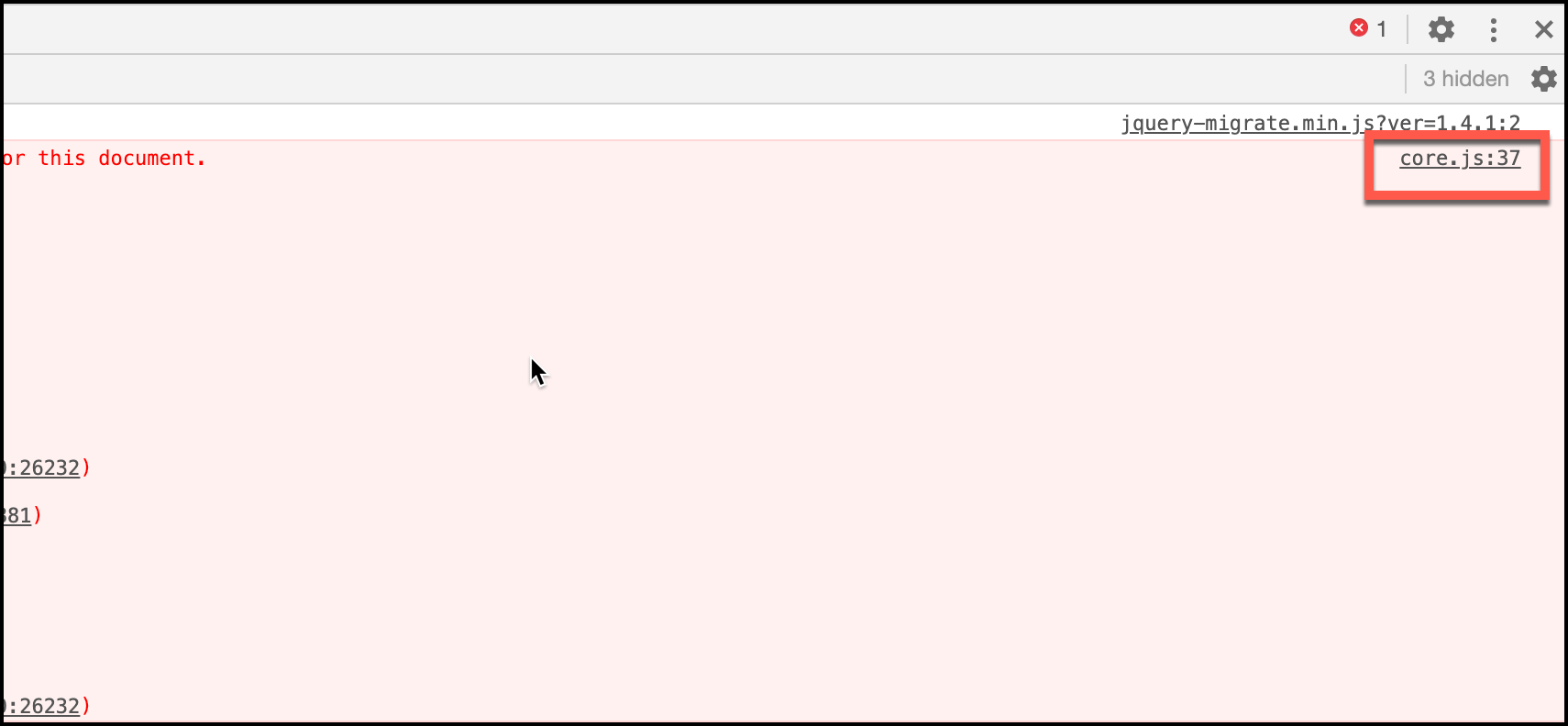
There are three types of messages Chrome DevTools shows – Informational, Warning, and Error. Informational Message is displayed without any background color. Warning message in Yellow and Error in Red background color.
If you want to view only Error messages, you can select ‘Errors’ in the ‘Default Levels’ drop-down.
Console’s Command Prompt
Console panel has its Command prompt. It is a node command prompt. If you want to run any JavaScript snippets on a webpage, you can use this command prompt. Where can I find the command prompt? You can find the command line cursor below the log messages.
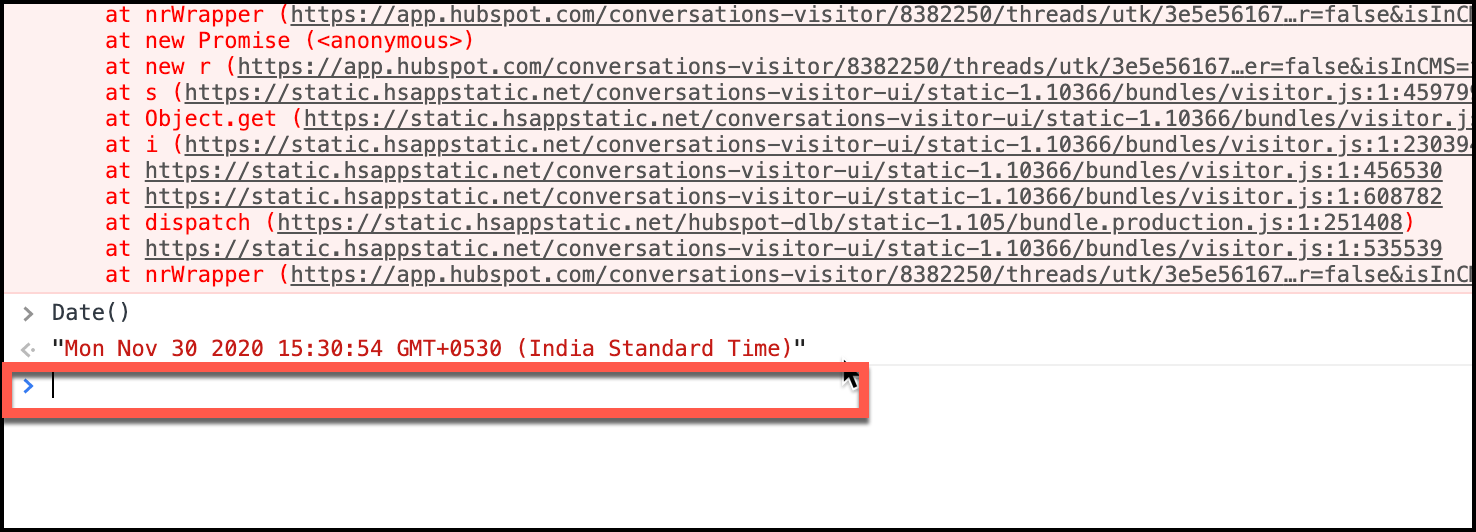
Selecting Elements
Everyone is aware that we can search elements in the Elements panel using XPath/CSS Selector. However, you can select an element in the DevTools Console panel as well. If you know about the ‘document.querySelector’ method, then it is straight-forward.
‘document.querySelector’ method accepts a CSS selector as an argument, and it selects only one element. If you want to select multiple elements, use the ‘document.querySelectorAll’ method in Console’s command prompt.
Using the ‘document.querySelector’ method, it returns one element, and you can focus on that element without any distraction. Whereas in Elements panel, it just highlights the selected element.
Selenium Chrome DevTools Protocol (CDP)
Now Selenium 4 has support to listen Console log messages. Manually, you can open the console panel and monitor the logs. However, in automation testing, there was no way to listen the logs.
DevTools devTools = driver.getDevTools();
devTools.createSessionIfThereIsNotOne();
devTools.clearListeners();
devTools.send(Log.enable());
devTools.addListener(Log.entryAdded(), logEntry -> {
System.out.println(logEntry.getText().contains("404"));
});
driver.get("https://codoid.com/fafafafsasf");
In Selenium 4, using Chrome DevTools Protocol, you can listen the logs. Refer to the below code. Note: Selenium 4 is not released yet. We have used Selenium 4 alpha version to accomplish the snippet.
In Conclusion
As a QA Company, we use the Chrome Console panel to access logs messages and report the errors to our clients’ developers. In the subsequent blog articles, we will be publishing on Chrome DevTools’ other panels.











